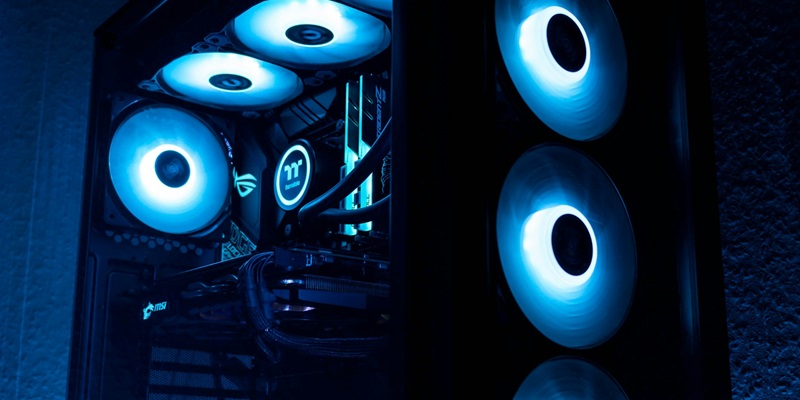NVIDIA’s RTX 2000 Ada, a new entry in its graphics lineup, revolutionizes entry-level workstation performance. It’s optimized for compact workstations, making it an ideal choice for professionals who have limited space but need robust graphical processing. Despite its small size, it doesn’t compromise on power.
With the RTX 2000 Ada, NVIDIA manages to blend power with efficiency in an impressive way. Its TDP is under 75 watts, which means it offers strong performance without excessive power consumption. This balance is critical for workstations that operate in environments where both space and power are at a premium.
This new graphics card by NVIDIA is a testament to their commitment to serve the needs of users who want to maintain a small workstation footprint without sacrificing the visual power required for professional tasks. The RTX 2000 Ada is a smart choice for power and space efficiency in the world of graphics-intensive workloads.
Unveiling the RTX 2000 Ada: Power Meets Efficiency
As NVIDIA gears up to release the RTX 2000 Ada, the anticipation builds within the tech community. This groundbreaking GPU sets out to seamlessly blend efficiency with robust performance and is designed for professionals who demand trustworthy workstation graphics without the cumbersome hardware often associated with powerful units. Boasting a TDP under 75 watts, the RTX 2000 Ada is set to slide into constrained spaces typically challenging for managing heat. This GPU is crafted not only to fit into compact work areas but also to offer substantial performance, providing an efficient solution without compromising on the needs of entry-level workstation users. Its low power needs and small footprint make it a desirable choice for a variety of professional applications.
The RTX 2000 Ada continues the legacy of NVIDIA’s low-power design, marrying the company’s renowned graphics performance with an energy-conscious footprint. The upcoming model is favored by those who operate within tight spaces yet require the graphical muscle to tackle advanced tasks. It’s expected to maintain the promise of NVIDIA’s workstation lineup—delivering exceptional graphics performance in a package that’s accessible to the mainstream market.
Retail Insights and Expected Pricing Strategy
Leaks suggest NVIDIA’s RTX 2000 Ada series could launch soon, including two variants, with one aimed at enterprises (the “E” model). This “E” version is expected to be priced between $500 and $630, offering a cost-effective choice compared to the standard model. Such pricing reflects NVIDIA’s ability to understand and cater to varying market needs, providing solutions tailored to different user groups.
The enterprise version indicates that NVIDIA is ready to provide customized features for professional use cases. This targeted approach shows that NVIDIA is considering the specific needs of its clientele, ensuring they can access the right technology fitting their budget and performance requirements. Consequently, professionals expecting reliable graphics performance without breaking the bank may find NVIDIA’s new offering particularly appealing as it promises to balance cost with capability.
Leaked Specifications and the RTX Legacy
Leaks hint at enticing prospects for the RTX 2000 Ada, with projections suggesting the inclusion of 8GB GDDR6 memory and compatibility with a PCIe 4.0 x16 interface. But patience is required for the full reveal of specs, as anticipation mounts. Looking to its forebear, the RTX 4000 SFF, the RTX 2000 Ada is anticipated to follow in its design footsteps with a cooling solution tailored for moderate power consumption, ensuring effective thermal management. The meticulousness of NVIDIA’s cooling strategies is expected to maintain system stability and performance regardless of the confined nature of the workstation setups involved.
Bearing the torch of NVIDIA’s highly regarded SFF lineage, the RTX 2000 Ada appears poised to continue the series’ dedication to compact and efficient design principles. Enthusiasts and professionals alike can anticipate a cooling system that complements the GPU’s power profile perfectly, certifying utmost performance within the constraints of small-scale workstation environments. The compact design, combined with careful thermal considerations, positions the RTX 2000 Ada as a vital cog in the workforce of space-conscious professionals.
The ADA Workstation Series: A Spectrum of Performance
NVIDIA’s RTX 2000 Ada series marks a landmark expansion in their workstation GPU offerings, tailored to meet the computing needs of a wide professional audience. This series ranges from the powerful RTX 6000 Ada to the compact RTX 2000 SFF Ada, highlighting NVIDIA’s dedication to diversity in performance, memory size, and cost. Built on TSMC’s advanced 4N process, the Ada line promises an optimal graphical solution for everyone, from data analysts requiring robust processing abilities to creators seeking a blend of sleek design and capability.
This wide-ranging suite of products exemplifies NVIDIA’s strategy to envelop every sector of the professional market. It’s an ambitious push to ensure that regardless of individual needs, professionals will find an Ada GPU tailored to their tasks. The extension of the Ada series conveys a clear message: NVIDIA is committed to providing the right technological tools for every professional demand, reinforcing their presence across the industry’s myriad niches.
Catering to a Broad Range of Professional Needs
By releasing the RTX 2000 Ada, NVIDIA is addressing the growing need for cost-effective solutions that do not sacrifice workstation-grade functionality. Signaling a broader range to accommodate more consumers, NVIDIA acknowledges the varied demands of today’s professional landscape. The GPU manifests the company’s drive to enrich its offerings across the spectrum of professional graphics cards. Merging energy efficiency with performance and affordability, NVIDIA continues to vie for a leading position in a market segment where such combinations are highly prized.
The RTX 2000 Ada is poised to fulfill the many practical needs of the modern workforce. Harmony between performance, energy consumption, and cost becomes more crucial as workstations become more centralized in professional settings. NVIDIA’s latest GPU is a testament to that balance, aiming to equip the broad array of professionals with a machine that resolves their everyday graphical challenges efficiently and affordably.

